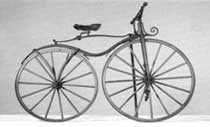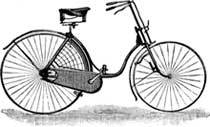Staying Safe on the Road A Two-Wheeled History
The precursor of the bicycle was patented by the German inventor Karl von Drais (1785-1851) in 1818. This vehicle, built almost entirely of wood, consisted of two wheels and a frame, which the rider straddled and propelled with his feet. Drais called it a Laufmaschine ("running machine"), and it was later called a velocipede as well as a draisine and a dandy horse. (A modern version of a running or walking bicycle is still used, to teach little children the balance and steering skills needed to ride a bicycle.)
|
Bicycle patent holder Pierre Lallement demonstrates the penny-farthing bicycle in 1886. This type of bicycle got its name from the differing sizes of its wheels; the size difference was comparable to the English penny and farthing coins. This penny-farthing was difficult to balance on and soon fell out of favor. |
The Velocipede, seen here in an 1868 model, is an early example of a bicycle. The pedals are directly connected to the front axel. These early bicycles were known as “boneshakers” because they had no suspension system and were ridden on bumpy rutted roads. |
The invention of the first pedal-propelled bicycle is often credited to a Scottish blacksmith named Kirkpatrick MacMillan (1812-78). The claim (by his nephew) that he produced a rear-wheel-driven bicycle has been called into question, however. On the other hand, the first patent for a pedal-driven bicycle was filed in the United States in 1866 by a recently arrived Frenchman called Pierre Lallement. Before he left Paris, he may have been associated with Pierre Michaux (1813-83), who in 1868 formed a partnership that began manufacturing bicycles. Michaux’s design may have been his own, but it looked very much like Lallement’s.
The first commercially produced bicycle, known as the "bone-shaker," had an iron frame. Its cranks and pedals attached to the hub of the front wheel, which was larger than the back wheel and revolved once with every turn of the pedals. This meant that the larger the wheel, the faster the bicycle traveled, a circumstance that quickly led to the development of huge front wheels (now with wire spokes) and tiny rear wheels. In Britain, these high bicycles became known as penny-farthings (for the huge British penny and the much smaller farthing coin). They were manufactured by the inventor James Starley (1830-81), who added improvements such as the tangent spoke (which runs tangential to the rim and crosses other spokes), ball bearings, solid rubber tires, and hollow-section steel frames. Nevertheless, the high bicycles, with the rider perched atop the front wheel, were very unstable, which is to say dangerous.
|
The safety bicycle, with wheels of equal size and balloon tires, was invented in the late 1880s. The model above, from 1887, is one of the earliest safety bicycles, because it has hard wheels. |
|
The women’s safety bicycle, from 1889, included a guard over the chain and sprocket mechanism, to prevent long dreses from getting caught. |
In 1885, Starley’s nephew, John Kemp Starley, introduced what became known as the English "safety bicycle." This bicycle, which incorporated a chain-and-sprocket rear-wheel drive invented by one Henry Lawson in 1879, had wheels of equal size. With the development of such features as the diamond frame (with a bar from the tube that holds the handlebars to the tube that holds the seat, popularly known as a boy’s frame), pneumatic tires, two- and three-speed hub (internal) gears, and then derailleur (external) gears, the modern bicycle was essentially in existence by the turn of the 20th century.
In the days of the penny-farthing, the bicycle was a vehicle for adventurous recreation, favored chiefly by young men. The safety bicycle, on the other hand, could be ridden by anyone and soon was. In the early years of the 20th century, it became popular both for recreation and for transportation in both Europe and North America. It was taken to Africa and Asia by European colonialists.
With more riders came more types of bicycles, and more uses for these bicycles.
This content has been re-published with permission from SEED. Copyright © 2025 Schlumberger Excellence in Education Development (SEED), Inc.





